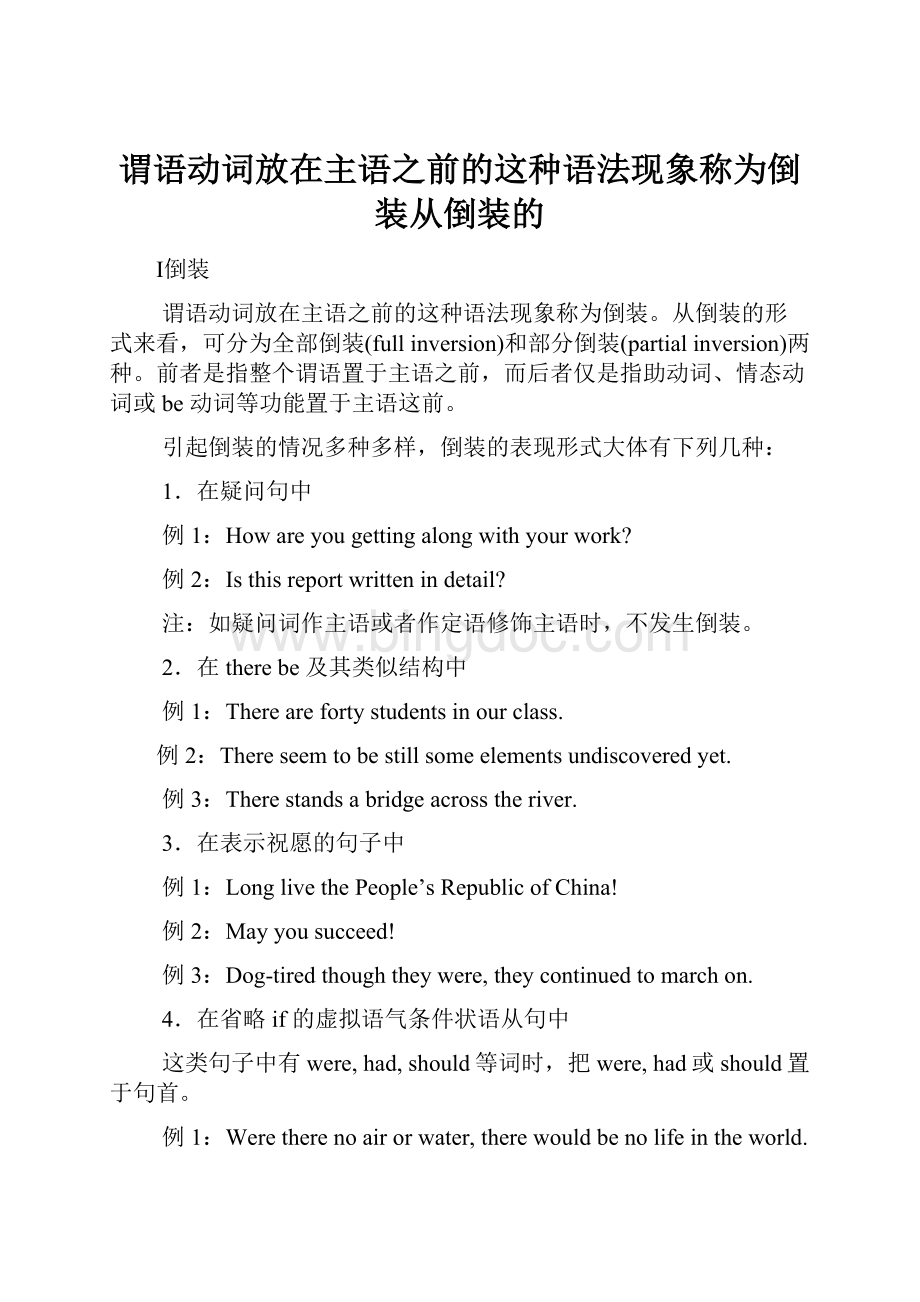谓语动词放在主语之前的这种语法现象称为倒装从倒装的.docx
《谓语动词放在主语之前的这种语法现象称为倒装从倒装的.docx》由会员分享,可在线阅读,更多相关《谓语动词放在主语之前的这种语法现象称为倒装从倒装的.docx(92页珍藏版)》请在冰点文库上搜索。

谓语动词放在主语之前的这种语法现象称为倒装从倒装的
Ⅰ倒装
谓语动词放在主语之前的这种语法现象称为倒装。
从倒装的形式来看,可分为全部倒装(fullinversion)和部分倒装(partialinversion)两种。
前者是指整个谓语置于主语之前,而后者仅是指助动词、情态动词或be动词等功能置于主语这前。
引起倒装的情况多种多样,倒装的表现形式大体有下列几种:
1.在疑问句中
例1:
Howareyougettingalongwithyourwork?
例2:
Isthisreportwrittenindetail?
注:
如疑问词作主语或者作定语修饰主语时,不发生倒装。
2.在therebe及其类似结构中
例1:
Therearefortystudentsinourclass.
例2:
Thereseemtobestillsomeelementsundiscoveredyet.
例3:
Therestandsabridgeacrosstheriver.
3.在表示祝愿的句子中
例1:
LonglivethePeople’sRepublicofChina!
例2:
Mayyousucceed!
例3:
Dog-tiredthoughtheywere,theycontinuedtomarchon.
4.在省略if的虚拟语气条件状语从句中
这类句子中有were,had,should等词时,把were,had或should置于句首。
例1:
Weretherenoairorwater,therewouldbenolifeintheworld.
例2:
Hadyoubeenmorecareful,suchspellingmistakesmighthavebeenavoided.
5.在so,nor,neither或nomore开头的句子中
此类句子通常表示前面一句话中的谓语所说明的情况,也适用于另一句中的主语。
例如:
1)Thisproblemisnotdifficultandneitheristhatone.
2)Coalisunderthegroundinsomeplaces,andsoisoil.
6.在以具有否定意义的副词、连词及词组开头的句子中
这些词和词组通常有:
rarely,never,scarcely,nosooner,little,few,hardly,seldom,atnotime,innoway,onnoaccount,nowhere,nobody,notonly等。
例如:
1)Visitourstores.Nowhereelsewillyoufindsuchmagnificentbargains.
2)Hardlyhadhefinishedhisworkwhenthetelephonerang.
3)Notonlydidhecomplainaboutthefood,healsorefusedtopayforit.
4)Littledidwethinkhisspeechhadmadesodeepanimpressiononhisaudience.
7.在强调表语时
例1:
Worstofallwerethehumiliations.
例2:
Suchisthecase.
8.在强调宾语时
例1:
Stillgreatercontributionsshouldwemaketooursocialistconstruction.
例2:
Usefulchemicalfertilizercanwemakefromthewasteliquid.
注:
当前置宾语由“nota+名词”或者“notasingle+名词”构成时,也会引起倒装。
例如:
Alicehadaterribletimetouringthatcountry.Notadaydidshespendwithouthavingsomeunpleasantnesswithwaitersinthehotel.
9.在强调状语时
(1)当句首状语为方位词或拟声词,谓语动词为go,come等表示位置转移的动词时句子须倒装。
例如:
1)Upwenttheplane.
2)Incamethechairmanandthemeetingbegan.
注:
如果主语是代词则不发生倒装。
例如:
1)Outtheyrushed!
2)Lowerandlowerhebent.
(2)当句首状语为表示地点的介词词组时,句子须倒装。
例如:
1)Roundthecornerwalkedalargepoliceman.
2)Underthetablewaslyingahalf-consciousyoungman.
(3)当句首状语由“only+副词”,“only+介词词组”,“only+状语从句”构成时,句子须倒装。
例如:
1)Onlyyesterdaydidhefindoutthathiswatchwasmissing.
2)Onlybecausethereweresomecancelledbookingsdidhegetsometicketsintheend.
(4)当句首状语为here,there,now,then等时,句子须倒装,主语是代词时,句子不用倒装。
例如:
1)Hereisaticketforyou.
2)Nowcomesyourturn.
3)Herehecomes.
(5)以关联词so(…that)开头的句子中,句子须倒装。
例如:
1)SosmallwasthemarkthatIcouldhardlyseeit.
2)Soquicklydidtheworkmenfinishtheirworkthattheyweregivenabonus.
3)Somuchdoesheworryabouthisfinancialpositionthathecan’tsleepatnight.
注:
在该结构中,“so+形容词”是表语的前置;“so+副词”是状语的前置。
10.在直接引语之后
在叙事性书面语中,直接引语后常跟askedMary,answeredJohn,saidtheoldlady,gruntedPeter之类的词语。
在这些词语中,动词常的主语之前,主语是代词时,不用倒装。
例如:
1)“Whatdoyoumean?
”askedHenry.
2)“Whatdoyoumean?
”heasked.
11.often,manyatime等表示频度的状语置于句首时
例如:
Oftendidtheythinkofgoingthere,buttheyneverhadachance.
12.在as,though引导的让步状语从句中
在as,though引导的让步状语从句中,一般将形容词、副词或名词等置于句首。
例如:
1)Smallastheatomis,wecansmashit.
2)Bigastheworkpieceis,itisturnedoutwithmuchsmallermachinetools.
Ⅱ替代
替代是一种避免重复的连接上下文的手段。
在英语中主要有三种替代现象:
名词性替代、动词性替代和分句性替代;同理,替代词也分为名词替代词、动词替代词和分句替代词。
此外还有状语的替代。
一、名词性替代
用名词性替代词one(s),thesame,thekind,thesort等所表示的替代现象叫做名词性替代。
1.名词性替代词
例1:
Thechilddoesn’tlikethisbook.Showhimamoreinterestingone.(one=book)
例2:
Hisnovelisabadoneforchildren.(one=novel)
2.某些不定代词
在名词性替代中还可以用一些不定代词来替代。
如all,both,some,any,enough,several,none,many,much,more,(the)most,(a)few,another,theother,others,either等。
例如:
Idon'twantanymorefood.I’vehadenough.
3.one和ones是最常见的替代词
one的复数形式是ones.one和ones作为替代词只能用以替代可数名词,不可用来替代不可数名词。
例如:
1)Thegreyhorseisstrongerthantheblackone.
2)Thenewdesignismuchbetterthantheoldones.
4.名词性物主代词mine,yours
名词性物主代词mine,yours等可用来代替my+名词,your+名词等,例如:
“Whoseisthatcoat?
”“It’smine.”
二、动词性替代
用动词替代词do,doso等所表示的替代现象叫做动词性替代。
1.谓语的替代形式
do是谓语的替代形式,有时态和人称的变化。
例如:
1)Somepeoplelikeashoweraftertheyhaveplayedtennis.Peterdoes,forexample.
2)JohnspeaksGermanasfluentlyasMarydoes.
2.由do,so等组成的复合替代形式
(1)“so+助动词+主语”。
例如:
“MarywillentertheuniversityinSeptember.”“SowillJoan.”
(2)“so+主语+助动词”。
例如:
“I’vebeentoBeijing.””Soyouhave.”
注:
这种结构中第二句的主语与第一句的主语是同一个人,否则应像“so+助动词+主语”的结构一样,主谓要倒装。
(3)“主语+(助动词+)do+so”。
例如:
“Haveyousentyourplantothecommittee?
”
“Ididsoyesterday.”
(4)“主语+(助动词+)do+that”。
例如:
“Doyouknowwhobrokethetelevisionset?
”
“IheardJohndidthat.”
(5)“主语+(助动词+)do+it”。
例如:
“MybrothersaidhewasgoingtosendaletterofprotesttothePresident.””Ididitlastweek.”
注:
如果上文表示否定意义而在简短反应中表示相同的看法时,则用“neither/nor+do+主语”。
此时,do不是动词替代词,而是助动词。
例如:
Marydidn’tlikeEnglish,neitherdidherbrother.
3.to代替整个动词不定式
当某个动词不定式词组在句子中再次出现时,我们可以只用to这个词,而不必重复整个动词不定式词组。
例如:
1)IwenttherebecauseIwantedto.(=…becauseIwantedtogothere.)
2)PerhapsI’llgotoBrazilthissummer;I’dverymuchliketo.
3)“AreyouandGilliangettingmarried?
””Wehopeto.”
4)Ithinkheshouldgetajob,butyoucan’tforcehimtoifhe’snotready(to).
5)Idon’tdancemuchnow,butIusedtoalot.
6)We’llneverleavehome;hehasn’tgotthecourage(to).
注1:
有时to可省略(尤其是在形容词和名词之后,见例4、6)。
在某些动词(如try)之后也可省略to。
例如:
“Canyoustartthecar?
”“Ok,I’lltry.”
注2:
在want和wouldlike之后,通常不能省略to。
然而,当want或like用于从句时(例如,在when,if,what,as之后),to常常省略。
例如:
1)Comewhenyouwant.
2)I’vedecidedtodowhatIlike.
3)Comeandstayaslongasyoulike.
三、分句性替代
用分句替代词so或not替代整个分句的现象叫做分句性替代。
例如:
Manypeoplebelievethattherewillbeanotherworldwarbeforetheendofthecentury.Myfatherthinkso,butIbelievenot.
1.分句替代词so或not可替代that从句
so可用来替代肯定的that从句,not替代否定的that从句,它们常与I’mafraid,believe,expect,fear,guess,hope,suppose,think等词语搭配。
例如:
1)“Havewegotenoughmoney?
”“Ithinkso.”
2)“We’renotgoingtobeintime.”“No,Isupposenot.”
2.so与not可用来代替if后面的从句
例1:
Areyoufreethisevening?
Ifso,comeandhaveadrinkwithus.
例2:
Areyoubusythisafternoon?
Ifnot,Iwishyouwouldstaywithmeforawhile.
3.用it,this,that,such作为替代词
例1:
Ifyoudon’tworkhard,you’llregretit.(regretit=regretnotworkinghard)
例2:
Hewasverytired.Thisexplainswhyhewenttobedearly.
例3:
You’retryingtocutwiththebackoftheknife;that’sasillythingtodo.
例4:
Imayhurtyourfeelings,butsuch(=that)wascertainlynotmyintention.
四、状语的替代
1.时间状语的替代形式主要用副词then
例如:
WesawJohnateightonMondayevening.Wetoldhimthenthatwecouldbecomingtotheparty.
2.地点状语的替代形式主要用副词here和there
例如:
MaryisinLondonandJohnistheretoo.
It和that有时也可以用作地点状语的替代形式,这种场合的it和that在句中作主语,并可同there交换使用,谓语动词是联系动词。
例如:
Theysatrightinfrontofthestage.That/it/Therewaswherethenoisewasgreatest.
3.方式状语的替代形式用inthatway和likethat
例如:
“Sheplaysthepianowithgreatconcentrationandwithgreatenergy.”“I’mafraidshedoesn’tstudylikethat.”
I一致性
一、主谓一致
主谓一致有许多原则,概括起来不外乎三种一致原则,即语法形式一致,概念一致(语言内容上一致),毗邻一致(谓语动词的单复数形式和紧位于其前的主语一致)。
1.语法形式一致
(1)单数主语、单个动词不定式、动名词短语以及句子作主语,谓语动词要用单数形式。
复数主语,用and或both…and连接的动词不定式短语、动名词短语以及主语从句作主语,谓语动词则用复数形式。
例如:
1)Theperformancewasveryfunny.
2)Servingthepeopleismygreathappiness.
3)Whetherwe’llgodependsontheweather.
4)Manynaturalmaterialsarebecomingscarce.
5)BothyouandIarestudents.
6)WhatIthinkandwhatIseekhavebeenfairlyreflectedinmypaper.
注1:
在what引导的主语从句中,如果主语补语是复数时,谓语动词用复数形式。
例如:
Whatwehavetolearnarethepiecesoflanguagethatproduceinversion.
注2:
修饰语对主语的数不起影响。
例如:
Theperformanceofthefirstthreeclownswasveryfunny.
(2)由aswellas,with,alongwith,like,togetherwith,ratherthan,except,but,including,accompaniedby,plus,besides,inadditionto,nolessthan等引起的结构跟在主语后面,不能看作是并列主语,该主语不受这些词组引导的插入语的影响,主语如是单数,其谓语动词仍然用单数形式。
例如:
1)Mymother,aswellasmyfather,hasakeytotheoffice.
2)ThemantogetherwithhiswifeandchildrensitstherewatchingTV.
3)Hissisternolessthanyouiswrong.
4)Thereadingcoursebook,plusitsreferencebooks,ishelpfultocollegestudents.
注:
有时在with结构里,加上both之后,with就具有and含义。
例如:
GrandpaWangwithhisson,bothlookingveryhappy,aretakingawalkinthepark.
(3)有些代词只能指单数可数名词,当它们在句子中作主语时,尽管在意义上是多数,谓语动词仍要用单数形式。
这类代词有either,neither,each,one,theother,another,somebody,someone,something,anyone,anything,anybody,everyone,everything,everybody,noone,nothing,nobody等。
例如:
1)Neitherlikesthefriendsoftheother.(两人都不喜欢对方的朋友。
)
2)Everythingaroundusismatter.(我们周围的所有东西都是物质。
)
(4)在neitherof与eitherof的结构里,一般语法书都认为谓语动词可用单数形式也可用复数形式,但在美国的TOEFL考试内要求用单数形式。
例如:
1)Neitherofthemwasingoodhealth,butbothworkedveryhard.
2)Haseitherofthembeenseenrecently?
(5)当and连结的两个名词是指同一个人或同一件事,and后的名词前没有冠词,谓语动词应该用单数形式;在and后面的名词前有冠词,谓语就用复数形式。
例如:
1)Thebreadandbutterisservedforbreakfast.(早饭供应黄油面包。
)
2)Thebreadandthebutterareonsale.(正在出售黄油和面包。
)
(6)当oneof,aportionof,aseriesof,aspeciesof,achainof结构作主语时,谓语动词要用单数形式。
例如:
1)Oneofthosestudentshaspassedtheexamination.
2)Aseriesofpre-recordedtapeshasbeenpreparedforlanguagelaboratoryuse.
(7)formof,typeof,kindof结构的谓语视form,type与kind的单复数而定.these/thosekind/typeof后是复数名词,谓语动词用复数形式。
例如:
1)Thekindofbooksanauthorwritesdependsonthekindofmanwhoheis.
2)Somenewtypesofcarsarenowonshow.
3)Thesekindofrecordersaregood.
(8)由oneandahalf+复数名词作主语时,谓语动词视名词的单复数形式而定。
例如:
Oneandahalfapplesisleftontheplate.
(9)由themajorityof+名词作主语时,谓语动词视名词